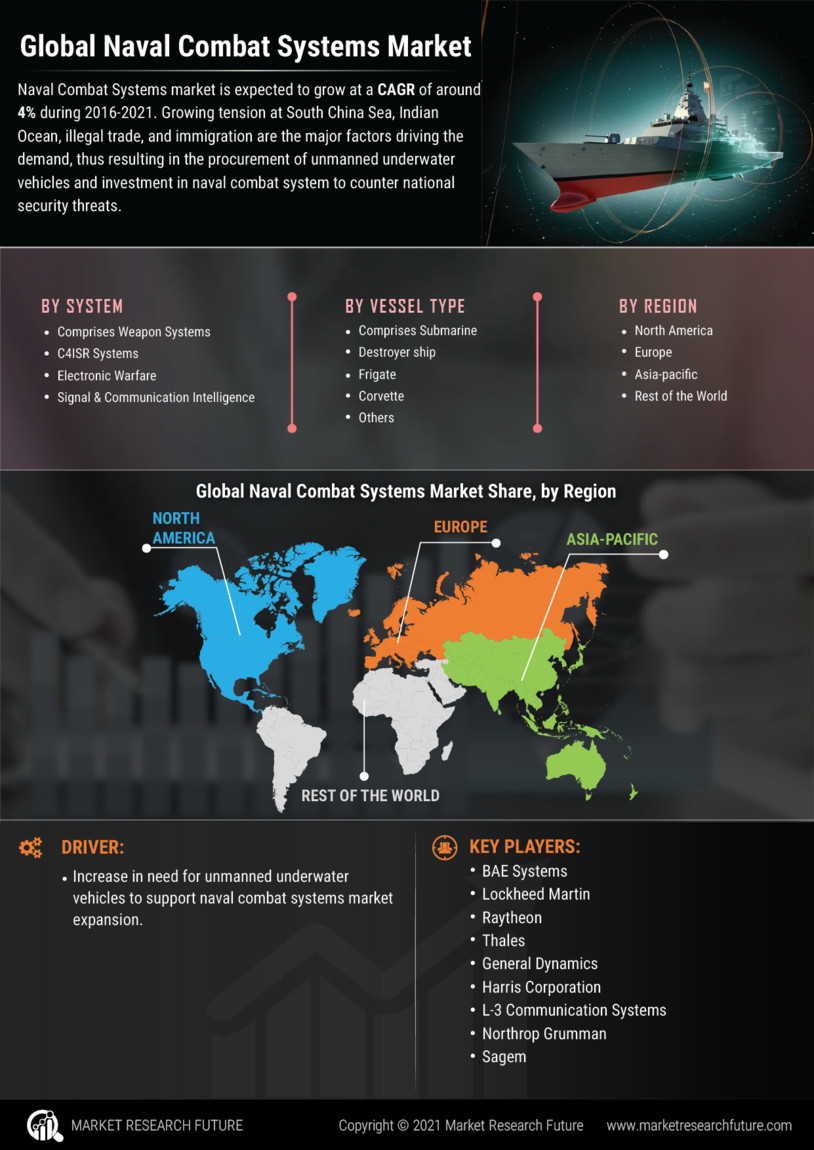Increased Geopolitical Tensions
The Naval Combat Systems Market is significantly influenced by rising geopolitical tensions across various regions. Nations are increasingly investing in their naval capabilities to assert dominance and protect national interests. The ongoing territorial disputes in the South China Sea and the resurgence of military activities in Eastern Europe have prompted countries to enhance their naval forces. For example, defense budgets in several nations have seen a marked increase, with naval expenditures projected to rise by 6% annually in response to these tensions. This escalation in military readiness is likely to drive demand for advanced naval combat systems, including surface combatants, submarines, and naval aviation assets. As countries seek to modernize their fleets, the market for naval combat systems is expected to expand, reflecting the urgent need for enhanced maritime security and deterrence capabilities.
Emerging Naval Powers and Defense Spending
The Naval Combat Systems Market is witnessing a shift as emerging naval powers increase their defense spending. Countries such as India, Brazil, and South Korea are expanding their naval capabilities to enhance their strategic positions. This trend is characterized by significant investments in modernizing fleets and acquiring advanced combat systems. For instance, India has announced plans to increase its naval budget by 10% over the next fiscal year, focusing on indigenous shipbuilding and advanced weaponry. This influx of investment from emerging naval powers is likely to stimulate competition in the market, driving innovation and technological advancements. As these nations seek to establish themselves as formidable maritime forces, the demand for sophisticated naval combat systems is expected to rise, contributing to the overall growth of the industry.
Focus on Cybersecurity in Naval Operations
The Naval Combat Systems Market is increasingly prioritizing cybersecurity as a critical component of naval operations. With the growing reliance on digital systems and networks, the vulnerability of naval assets to cyber threats has become a pressing concern. Recent reports indicate that cyberattacks on military systems have surged, prompting navies to invest in robust cybersecurity measures. This focus on cybersecurity is likely to drive the development of integrated combat systems that incorporate advanced cyber defense capabilities. As nations recognize the importance of safeguarding their naval assets from cyber threats, the market for naval combat systems is expected to evolve, with an emphasis on resilience and security. The integration of cybersecurity solutions into naval combat systems not only enhances operational effectiveness but also ensures the protection of sensitive information and critical infrastructure.
Sustainability and Environmental Considerations
The Naval Combat Systems Market is increasingly influenced by sustainability and environmental considerations. As global awareness of environmental issues grows, navies are exploring ways to reduce their ecological footprint. This includes the development of green technologies and energy-efficient systems within naval combat platforms. For example, the adoption of hybrid propulsion systems and alternative fuels is gaining traction, as navies aim to comply with international environmental regulations. The market for naval combat systems is likely to see a shift towards more sustainable practices, with investments in research and development of eco-friendly technologies. This focus on sustainability not only addresses environmental concerns but also enhances the operational efficiency of naval forces, potentially leading to cost savings in the long run. As a result, the integration of sustainability into naval combat systems is expected to shape future procurement strategies.
Technological Advancements in Naval Combat Systems
The Naval Combat Systems Market is experiencing a surge in technological advancements, which are reshaping the landscape of naval warfare. Innovations such as artificial intelligence, machine learning, and advanced sensor technologies are enhancing situational awareness and decision-making capabilities. For instance, the integration of unmanned systems is expected to increase operational efficiency and reduce risks to personnel. According to recent estimates, the market for naval combat systems is projected to grow at a compound annual growth rate of approximately 4.5% over the next five years, driven by these technological innovations. Furthermore, the development of next-generation combat systems, including advanced missile systems and cyber warfare capabilities, is likely to play a pivotal role in maintaining naval superiority. This trend indicates a shift towards more sophisticated and integrated combat systems, which could redefine naval strategies in the coming years.


















Leave a Comment